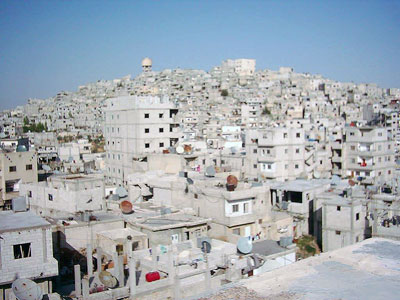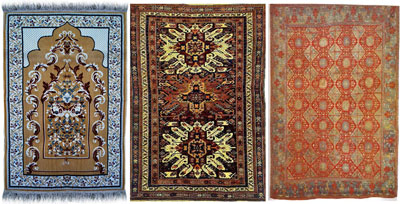A Rug - Post-orientalism
The on going debate on Arab identity and its (cultural) representation is strongly shaped by Edward Saidʼs formative and yet controversially discussed book Orientalism, first published in 1978. Accordingly, the patronizing presentations of the “East” by Western travellers, scholars and orientalists reflect romanticized ideas of people’s lives.
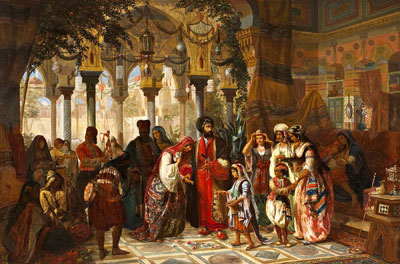
Jan Baptiste Huysmans, The presentation of the bride to the Court of Syria in Damascus 132 x 87 cm , Oil on panel / signed and dated 1860
The social, economical and cultural practices by the ruling Arab elite indicate an internalization of this projected image of “Arab Culture”. Over the decades this very notion was embraced by all classes, widening the misunderstanding of a different culture, with mass tourism and globalized economy as two of its vehicles.
Sulafa Hijazi embarked from there for her piece “A rug – post-orientalism”. During her conducted research, the pictures displayed here took her on a journey through plains of history, the violent changes in Syrian society, the transnational commerce and increased circulation of commodities. From a rather distinct idea of identity Sulafa moves to questioning the impact on self-representation expressed through cultural consumption goods in this work.
The layers for an approach to identity in general is mostly stimulated by ethnical, cultural and religious affiliations to family history, the position within society, class, conditioned and/or desired gender roles and expectations. The national identity can fill one with pride and produce obligations, can either be just a paper, a passport, or a rather crucial challenge, a course, not only shaping one’s self-conception, but predicating the perception and reaction of others. To a certain degree playfulness offers a diversity of possible narrations of identity according to the desired emphasis and current state of mind. Or, with the words of Stuart Hall: Identity is an endless ever unfinished conversation.
A “visual identity” is a term associated with a branding of a company or a group. The visual and verbal articulation reflecting the philosophy of that very entity should be convincing in appearance, it should be memorable and unique. The narrower the idea of a nation is, the more it understands itself as a company with a clear visual and overall identity.
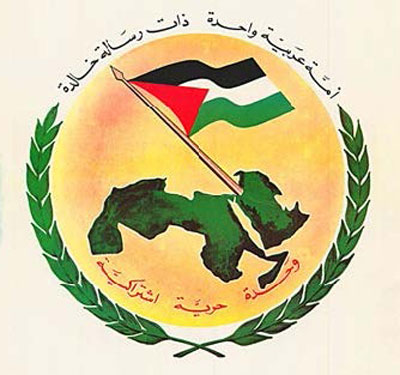
Arab Socialist Ba’ath Party Logo
Taste, sight, touch, smell and hearing can evoke memories, which are, debatably, part of an identity, mutual and/or personal. Beyond that shared and common views, urban and countryside landscapes, architecture and nature shape visual identities, belonging and attachments. Here, in the context of Syria, it reverberates a claimed socialist national identity, artificially shaped spaces of identities, as well as a state of corrupt economy. Vast areas with concrete buildings also indicate informal dwellings.
In the southwest of the Syrian capital Damascus lies the district Mezzeh 86 on one of the surrounding hills of the Greater Mezze district, close to a now wealthy upscale neighbourhood with ministries, embassies and villas.
After the uprising against the Assad regime by the Muslim Brotherhood and other Sunni Muslim groups in Hama which began in 1976 and was forcibly ended with a massacre carried out by the Syrian army under the command of Rifaat al Assad in February 1982, the repression against the Muslim Brotherhood widened in various Syrian regions. Hence, the land of Mezzeh 86 area was illegally seized from its original owners, Sunnis and Brotherhood members who lived there since many generations. Hafiz and Rifaat al-Assad gave it to Alawite soldiers and their families. Houses were quickly constructed of mud bricks and sheet metal. These houses have been transformed into concrete buildings without licences. A shantytown mentality promotes illegally procured water and electricity to sustain a rather poor infrastructure in narrow streets and alleys.
Later also farmers from around Latakia and other areas in Syria moved there. Despite the prevailing harsh living conditions, drought and hunger due to climate changes and infrastructure neglect, the government failed to provide any support. The forced migration to the city was rather used to form a “pocket of identity”: people and their informal living are condoned by the government with the consequence, that many of the inhabitants work for the intelligence service, the army and the national defence militias.
Another example for a place built on ethnic and geographical commonalities is the informal neighbourhood of Jabal al Riz, a shantytown, also known as Wadi al Mashari, the Valley Projects, in the municipality of Dummar, northwest of the city centre of Damascus. This area is home to Kurdish people who settled there coming from the North East of Syria. Though the land was not given to them, it’s where houses are mushrooming, built on top of each other, in suffocating manners. As Kurdish Syrian people do not enjoy the same rights as “Syrians” and are often deprived of identity cards and the use of their language, this settlement is only tolerated. People are forced to pay bribes to public officials to avoid arbitrary demolitions. Although close to middles class neighbourhoods, the area is cut off from rudimentary governmental services.
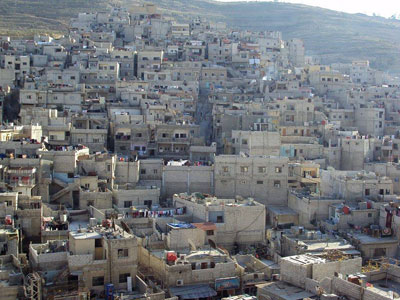
Jabal al Riz, Wadi al Mashari, Damascus
Not only are the cities built of concrete, giving the eye an exhausting impression of uniformity.
Over the last decades villages in the countryside have lost their traditional houses. Partially, because the traditionally used sandstone are unaffordable, partially, because the knowledge and skills to built with mud and straw are disappearing, and, last but not least, the corrupted network of the building industry is so dense, that there is no way to escape.
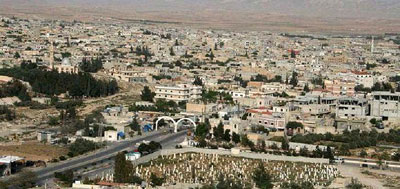
Jeiroud, country side northeast of Damascus
The remaining mansions built in traditional styles mirror power and prestige, wealth, class and exclusion, though some are turned into public buildings, housing parts of official canons. Historical architectural styles e.g. Ablaq, a technique first employed in the 12th century in Syria, was continued to be used in the Ottoman period. It involves alternating or fluctuating rows of light and dark stones, sometimes including red, white, black stones and various shades of brown.
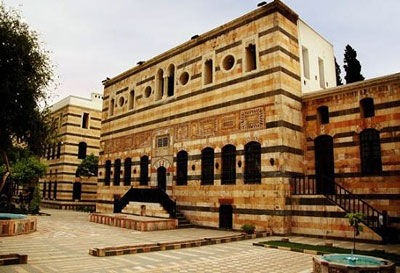
Al Azm Palace, built for the Ottoman ruler in Damascus in1750, now houses a museum of Arts and Popular Traditions
The days of an exciting and lively richness in colors, materials and shapes seem as long ago as the paintings of orientalists. The abundance of culture is reflected in rich private houses and museum collections, often abroad, transported to other countries, as a trophy coined to be safer there than in their original context. As part of the “modern times”, they are replaced by quickly built constructions of concrete and cement, by goods produced of low cost plastic and synthetic, thrown on the local market.
Traditional products become unaffordable for most and disappear more and more in average households, which deprives people of their cultural heritage. People holding on to few of remaining inherited objects. Locals find themselves confronted with a non-inspirational standardization of life on many levels. This tackles challenging questions of possible corrupt/new identities. Tourism goods, “local souvenirs” cheaply produced in China, are a global symptom of cultural sellout.
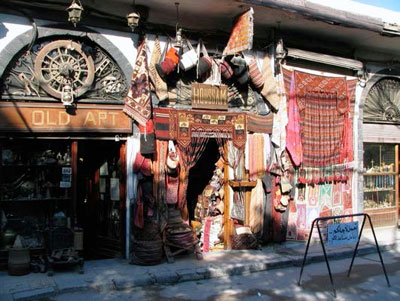
shop on Long Street, Bab Sharky, Damascus
New industries take over, accompanied by new rules and conditions. The concrete market is known for its corruption, not only in Syria. Additionally, the production of cement, the adhesive component for concrete, requires dynamite limestone of the earth’s crust to be cooked by 1482 degrees Celsius, which transforms the productive soil into hard baked clay. This leads to droughts, the loss of farmland and pasture, jeopardizing the livelihood and food resources of many.
Where once the constructions with mud, clay bricks and natural stones permitted a smooth adaptation to extreme temperatures during summer und winter, concrete buildings are extremely hot in summer and extremely cold and damp in winter.
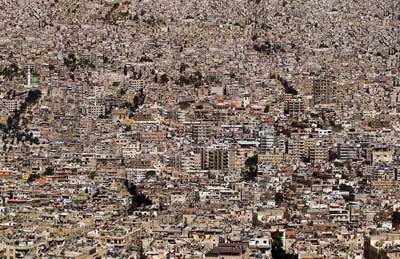
view across the city of Damascus
However, the excessive use of concrete for buildings lead to another association: the repetition of the same unites recalls the basic concept to reiterate geometric patterns in the Islamic decoration art. Whereas the geometric patterns in Islamic art occur in a variety of forms, colors and materials, the basic constant patterns of cement and concrete buildings are standardized and uniform. It appears like a superimposed strategy to cement anti-individualism, underpinning enforced conformity.
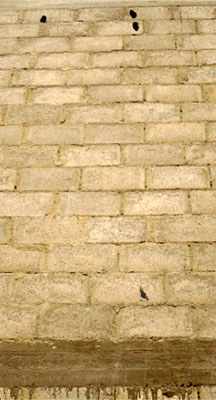
part of a concrete house wall in Jeiroud, countryside close to Damascus
Sulafa Hijazi decided to use the small prayer rug as a template for her piece. This prayer rug, essential for a clean location to individually perform the 5 everyday Muslim prayers in a private home varies in its design, but not in it’s seize. Yet, traditionally there are a number of symbols which are repeatedly represented on the woven or knotted carpet: the arched doorway or prayer niche, mihrab, layed out supporting the qibla, indicating the direction to Mecca.
Floral ornamentations depict the Garden of Eden and various versions of the tree of life. Often, they are combined with abstract elements of flora and fauna, stylized birds, flowers, trees and non-figurative emblems. Additionally, some may be adorned with verses from the Qur’an.
The making and the trade of hand made prayer rugs of good quality, wool and silk, were and still are a flourishing business. Not only are the rugs sold for their original purpose. They are also found in living rooms and foyers of people without Muslim believe. The antique market is also doing very well, so are the auctions with unique pieces for people who can afford to pay big sums. Refined and skilled craftsmanship are for a few.
The increasing vulnerable strata of society, along with growing global sectors of cheap labor and the usage of poor quality material accelerates mass production with low workmanship. In a vicious circle, they serve each other inseparably.
Residing in Frankfurt, Germany in 2014, when Jeiroud was met with shelling and bombing, Sulafa asked her cousin, who lives in this village northeast of Damascus, to send her photographs of the typical concrete walls now being the cultural landmark of Jeiroud. An image of the concrete bricks was printed onto a white woolen rug that has the identical dimensions of a Muslim prayer rug. The edges of the rug were handmade in an Iranian carpet store.
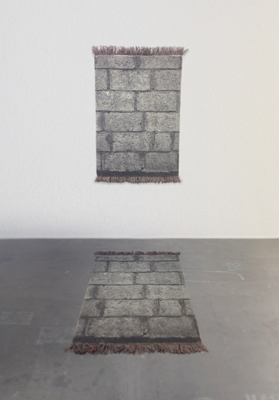
2 prayer rugs - post orientalism, print on carpets
In her work A Rug - Post-orientalis, Sulafa Hijazi tackles not only the loss of spirituality as an implicitness of the “modernity” we are facing, she also focuses on the economy behind the changes. By using an object dedicated to religious practice the work is also imbued by the question how much religion becomes a source of industry and whether the commodity market is the new religion.
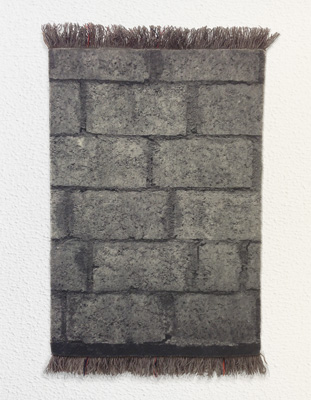
A Rug - Post-orientalism, 114 x 70 cm, print on carpet with hand knitted wool edges, by Sulafa Hijazi, 2014
project by Sulafa Hijazi, 2014
images collected from various sources
Text by Rayelle Niemann, 2017
edited by Ashraf Osman scentart
A Rug - Post-orientalism
ANOTHER PROJECT ON CITYSHARING
→ on going
RELATED WEB SITES
→ review “Animated Images”
→ artist’ s website
• A Rug - Post-orientalism •
[ Cairo Divided ]
[ City of Events: a Close Look at Al Abdali Bus Terminal and Beyond ]
[ DADA Houses & Bucharest Strip ]
[ DIWAN ]
[ Die letzte Buche - The last beech ]
[ Leerstand ]
[ Model Citizens ]
[ Mukhattat mabdaee lilmustaqbal—Blueprint of the Future ]
[ Presence ]
[ Psychogeography ]
[ R I C O R S O ]
[ Reaching Boundaries ]
[ up the hill down the hill - Bird Cages - an installation ]
FEATURED THEME ON CITY SHARING
by ASUNCION MOLINOS GORDO
-
This project is an instrument for common critical analysis to help understand the reasons behind Egyptians’ diminishing …
by INAS HALABI
-
The project Letters to Fritz and Paul focuses on the expeditions of the Swiss cousins, lovers and scientists, Fritz and …
by SARAH BURGER
-
The planned modern city of Brasilia attracted me since a long time. Her defined shape, location and function proceded he …
by ADRIEN GUILLET
-
Youri Telliug talks with the artist Adrien Guillet about his project Citracit
Youri Telliug - What is Citracit …
by NIGIST GOYTOM
-
In 2013 more than 45 million people have been forced to leave their homes. This amounts to the biggest number of refugees …
by SULAFA HIJAZI
-
The on going debate on Arab identity and its (cultural) representation is strongly shaped by Edward Saidʼs formative …
by ASUNCION MOLINOS GORDO
-
WAM is a site-specific work that uses the historical trope of the cabinet of curiosities to explore the introduction of …
MORE CONTRIBUTIONS BY THE FOLLOWING
